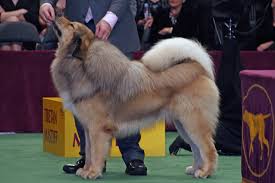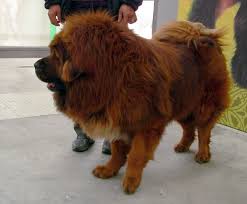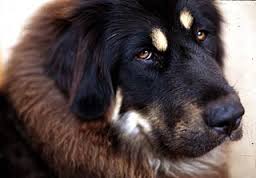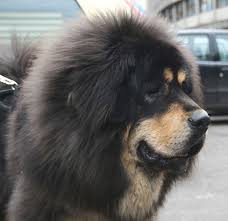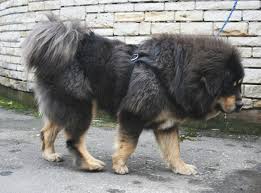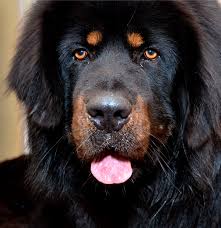Tibetan Mastiff
The Tibetan Mastiff, as the name suggests is a Breed of dog that hails from Tibet. This is a giant breed, weighing 80 to 150 pounds, with a calm and majestic presence. Like all dog breeds it might not be the right breed for everyone. They are a very gentle and patient dog. The Tibetan Mastiff is probably a good choice for children as they are quiet, watchful, and protective of their family. Their easy going nature makes them good with kids. They are protective though and are not a huge fan of strangers. They have a background as a village guardian and tend to bark a lot at night. Like many strong, powerful breeds, his protective nature is attractive to many, but that might not mean he is the best choice for a novice dog owner. He needs a strong, firm, consistent owner. They do not like hostile energy or confrontation of any kind. So don’t be surprised if you get a bad reaction while arguing in front of him. Due to this nature they aren’t always the best ones to watch over children as they might step in and be too aggressive to stop their roughhousing. They might think they are simply protecting them.
Like all dogs, especially large, powerful breeds, begin training them as soon as you bring your Tibetan Mastiff puppy home. The best thing you can do for them is to socialize them as much as possible. Put them in a puppy class and take them to the park to be around as many dogs as possible. Just take them with you everywhere you go. Take them into stores, over to friends houses, to the farmer’s market. Just get them out as much as possible. When training, always use positive reinforcement techniques such as praise, play, and food rewards, never be forceful.
While we really recommend that you acquire one through a rescue, we understand that some people might go through a breeder. Always screen your breeders as much as possible to ensure that you are getting as high a quality dog as is possible.
Once they’ve grown up, the mature Tibetan Mastiff has a low activity level, but puppies are active and need room to run in a safe, traffic-free area. Make sure that you have a high fence backyard to contain them. Never chain your dog outside! Not only is it inhumane it also leads to a very dangerous dog. All dogs need exercise. Even if it is just a slow walk, make sure that you are getting them out and keeping them moving. It is as good for them mentally as physically.
If you are interested in helping animal rescues raise money, please play our quiz. Each correct answer donates to help feed shelter animals.
Here are some pictures of the Tibetan Mastiff
Tibetan Mastiff History
The Tibetan Mastiff is one of the oldest breeds, they are considered to be the first ancestor of the other mastiff breeds in the world. In 2008, a mitogenome study concluded that 12 dog breeds studied appeared to have diverged from the gray wolf 42,000 years ago, the Tibetan Mastiff lineage diverged earlier at 58,000 years ago. He is one of the oldest known breeds. He is originally from Tibet where it worked as a guardian breed who either traveled with nomadic herdsmen, watching over their flocks, or served as the protector of villages and monasteries. Travelers often wrote of the dogs’ ferocity, which was encouraged by the inhabitants. There are are Chinese documents dating to 1121 BC that talk about the ferocity of Tibetan guard dogs. However, they weren’t introduced to the U.S until 1970.
Awesome videos of Tibetan Mastiff puppies
Tibetan Mastiff Size and Weight
Typically stand 24 to 26 inches.
Typically range from 75 pounds to 160 pounds.
Tibetan Mastiff Personality
The Tibetan Mastiff isn’t the most affectionate guy, but he fiercely loves his family. His main goal in life is to be with them and protect them. They might be nice to strangers once you have let them in the door and they know they are safe, but even then they might be a bit hesitant. He has literally been watching over people and property for more than 2,000 years. He is highly territorial in his own home and feels a strong need to defend and protect it.
When it comes to defending and protecting he likes to take over and be the decision maker. He thinks that he knows what needs defending and protecting and is going to make up his own mind.He can be rather strong willed and stubborn especially if he thinks it’s for your safety. It’s essential to establish yourself as a leader he can respect but without using force, harsh words, or physical punishment. The Dog Whisperer, is a great resource to see an example as to how to establish yourself as the pack leader.
It is very important to be consistent and firm with them. They are very sensitive to emotions. It’s not a good idea to argue with your spouse or spank your child in front of him. He may think it’s his job to intervene.
It is best to have a nice high fence backyard for him to roam in. And it also very important to take him on long walks where he can exercise. This is as good for him mentally as physically. His job in TIbetan villages was to to roam at night and bark to keep people away and warn of any threat. He will do the same if left outside in your backyard.
This is a good breed for children. It is far more important to teach your kids how to interact with your dog than vice versa. They need to learn how to interact with and be around the dog. It should really never be left along with young children in the off-chance that he would be aggressive. He will get along fine with other animals, especially if he is raised with them.
If you get one as a puppy, don’t wait until he is 6 months old to begin training. This will create bad habits that might be hard to stop. Go ahead and start training your puppy the day you bring him home. Do everything you can to socialize the young puppy. Take him to puppy classes, doggy day cares, etc. Just keep socializing him as much as you can.
Even though this refers to acquiring one as a puppy, you can also get one through a rescue and find a little bit older, more mature and well socialized dog looking for a new home.
Tibetan Mastiff Health
All dogs have the potential to develop genetic health problems as all breeds are susceptible to some things more than others. However, the one positive thing about getting a puppy is that you can avoid this as much as possible. A breeder should absolutely offer a health guarantee on puppies. If they won’t do this, then look no more and don’t consider that breeder at all. A reputable breeder will be honest and open about health problems in the breed and the incidence with which they occur. Health clearances prove that a dog has been tested for and cleared of a particular condition.
Here are some conditions that have been seen in the breed; hip and elbow dysplasia, hypothyroidism, persistent pupillary membranes (an eye disorder), and canine-inherited demyelinative neuropathy.
Hip dysplasia in Dogs is a disease of the hip in which the ball and socket joint is malformed. This malformation means that the ball portion and its socket don’t properly meet one another, resulting in a joint that rubs and grinds instead of sliding smoothly. Ask the breeder to show written evidence that a Dogo puppy’s parents have been cleared by the Orthopedic Foundation for Animals (OFA). .
Do not purchase a puppy from a breeder who cannot provide you with written documentation that the parents were cleared of health problems that affect the breed. A careful breeder and one who truly cares about the breed itself, screens their breeding dogs for genetic disease and breed only the healthiest and best-looking specimens. One of the most common health problems with dogs is obesity. Keeping this under control is your responsibility.
Tibetan Mastiff Care
The Tibetan Mastiff has a long, thick double coat. It is easy to recognize the males as they have a more lavish covering than females. There’s no need to trim any part of the coat unless you want to give the feet a neater appearance. He will need frequent brushing as he has such long hair. Bathe him as often as you think he needs it, but not too much where it will dry out his coat. Trim his toe nails every couple of months and brush his teeth or get him an approved bone to chew on that will clean them for you.
Tibetan Mastiff Feeding
A lot of times diet is done on a per-dog basis. Each one is unique and has different dietary requirements. Most dogs in the U.S. are overweight. A mix like this one that is prone to hip and elbow dysplasia should really be on fish oil and glucosamine and chondroitin supplements as soon as possible.
Overfeeding any dog is not a good idea as that can really exacerbate health problems such as elbow and hip dysplasia.
A good diet to look into is Raw Food Diet.

